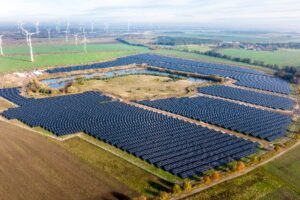Is Tidal Energy Renewable Or Nonrenewable?

Tidal energy, like other forms of renewable energy, has become increasingly popular in recent years as we seek to reduce our reliance on non-renewable resources. Tidal energy harnesses the power of the ocean’s tides to generate electricity. But is tidal energy renewable or nonrenewable? In this article, we will explore the answer to this question.
What is the Difference Between Renewable and Nonrenewable Energy Sources?
Renewable energy sources are those that can be replenished naturally and rapidly, such as solar, wind, hydro, geothermal, and biomass. They are also called clean energy sources because they emit little to no greenhouse gases and pollutants. On the other hand, nonrenewable energy sources are those that cannot be replenished naturally or quickly enough to keep pace with their consumption, such as fossil fuels like coal, oil, and natural gas.
The nonrenewable energy sources are also called dirty energy sources because they emit a lot of greenhouse gases and pollutants, contributing to climate change and air pollution. Renewable energy sources have several advantages over nonrenewable ones, such as lower operating costs, job creation, energy security, and environmental benefits. However, they also face some challenges, such as intermittency, variability, storage, and transmission. Therefore, a mix of renewable and nonrenewable energy sources is currently used to meet the world’s energy demand, but the transition to a more sustainable energy system is underway.
Is Tidal Energy Renewable?
Tidal energy is considered a form of renewable energy because it relies on the natural movement of the tides, which are caused by the gravitational pull of the moon and the sun. The tides are a reliable and predictable source of energy that is constantly replenished by the natural forces of the earth.
Unlike other forms of renewable energy such as solar and wind power, tidal energy is not affected by weather conditions. It is a consistent and reliable source of energy, and for this reason, can be used to generate electricity around the clock.
Tidal energy has been used for centuries, with early examples of tidal mills and waterwheels dating back to the Middle Ages. However, it is only in recent years that we have developed the technology to harness tidal energy on a larger scale.
Types of Tidal Energy Technology
There are two main types of tidal energy technology: tidal barrages and tidal turbines. Tidal barrages work by creating a dam across a tidal estuary or bay. As the tide comes in and out, the water flows through turbines in the dam, generating electricity.
Tidal turbines, on the other hand, are similar to wind turbines, but they are placed underwater and use the movement of the tides to turn the blades and generate electricity.
Is Tidal Energy Environmentally Friendly?
Tidal energy is often considered to be an environmentally friendly form of energy because it is a renewable energy source that does not produce greenhouse gas emissions or other harmful pollutants. Tidal energy is generated by capturing the kinetic energy of ocean tides, which are powered by the gravitational pull of the moon and the sun.
However, tidal energy projects can still have some negative impacts on the environment. For example, the construction of tidal turbines and associated infrastructure can disturb marine habitats and disrupt the movement of marine animals. There are also concerns about the noise generated by tidal turbines and the potential for collisions with marine animals.
Overall, while tidal energy has the potential to be a relatively clean and renewable source of energy, it is important to carefully consider the environmental impacts of individual projects and to implement mitigation measures to minimize any negative effects on the environment.
Tidal Energy Opportunities
Tidal energy presents several opportunities as a source of renewable energy.
Is Predictable
One major advantage of tidal energy is its predictability. Unlike wind or solar energy, which can be intermittent and unpredictable, the tides are a reliable and predictable source of energy. This can help to stabilize the grid and ensure a steady supply of electricity.
Tidal energy also has the potential to be a significant source of clean energy. According to estimates, the global potential for tidal energy is substantial, with the potential to generate up to 1,000 terawatt-hours of electricity per year. This is equivalent to the energy produced by more than 100 nuclear power plants.
Can Help Reduce Our Reliance On Fossil Fuels
Moreover, tidal energy can help to reduce reliance on fossil fuels and contribute to climate change mitigation efforts. It is a renewable and emissions-free source of energy, which can help to reduce greenhouse gas emissions and mitigate the impacts of climate change.
Creates Economic Opportunities and Jobs in the Energy Industry
Additionally, tidal energy can create economic opportunities and jobs in the energy industry. The development and deployment of tidal energy technologies can create new jobs in engineering, construction, and maintenance.
Overall, tidal energy presents several opportunities as a source of clean, reliable, and predictable energy. As technology advances and costs decrease, tidal energy is likely to become an increasingly important part of the global energy mix.
Tidal Energy Challenges
While tidal energy is a promising source of renewable energy, it faces several challenges that must be addressed for it to become a viable part of the energy mix.
High Cost
One major challenge is the high cost of developing and deploying tidal energy technologies. Tidal turbines and other infrastructure must be carefully engineered and constructed to withstand the harsh marine environment, which can be costly.
Tidal is a variable source of renewable energy
Another challenge is the variability of tidal energy. Unlike fossil fuel power plants, which can be turned on and off as needed, tidal energy is dependent on the tides and can only be generated during certain times of the day. This can make it difficult to integrate tidal energy into the grid and ensure a steady supply of electricity.

Tidal turbines are installed underwater in areas with strong tides, image source: Pixabay
Can disturb marine life
Additionally, there are environmental challenges associated with tidal energy. The construction of tidal turbines and other infrastructure can disturb marine habitats and disrupt the movement of marine animals. Noise generated by tidal turbines can also potentially harm marine life.
Limited number of suitable locations
Another challenge is the limited number of suitable locations for tidal energy installations. Tidal energy requires a significant tidal range, which is the difference in water level between high and low tides. Only a few locations around the world have a large enough tidal range to make tidal energy generation economically feasible.
Overall, while tidal energy offers many potential benefits, including its renewable and emissions-free nature, there are still several challenges that must be overcome to make it a feasible and sustainable energy source. Addressing these challenges will require continued research and development, as well as collaboration among stakeholders in the energy industry, government, and environmental groups.
Despite these challenges, tidal energy has the potential to play an important role in our transition to a clean energy future. In addition to being a reliable source of energy, tidal energy is also clean and produces no greenhouse gas emissions or pollution.
Conclusion
In conclusion, tidal energy is a form of renewable energy that harnesses the power of the tides to generate electricity. While it has its challenges, such as the high cost of infrastructure and limited suitable locations, tidal energy has the potential to be a significant contributor to our clean energy future. As we continue to develop and improve tidal energy technology, we may see more widespread adoption of this promising source of renewable energy.







